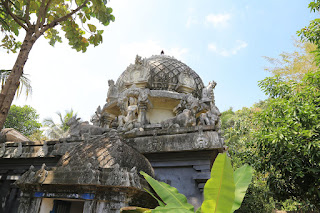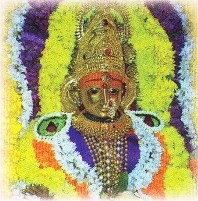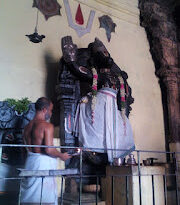Nerur Sadasiva Brahmendra – The Early Life and Enlightenment
This is a part of a series of articles on Sri Brahmendral
Sri Sadasiva Brahmendra was born to a Telugu couple, Moksham Somasundara Avadhaani and Parvati in Madurai in Srivatsa Gotra of the Velnadu clan. Moksham was their family name. Initially based in Madurai, His family later moved to Tiruvisainallur (also called Shahajirajapuram) near Kumbakonam, Tamil Nadu. Somasundara Avadhani was among the 46 eminent scholars who had received the grant of Tiruvisanallur Agrahara from king Shahaji (1684-1712) of Tanjore in 1693.
Somasundara Avadhani was disinterested in family life. So, the couple did not have a child till Avadhani reached 40 years of age. However, Parvathi was initiated into Rama Japa and advised her to chant it crores of times, so that every cell in her body would be charged with divinity and she would be purified in body, mind, and spirit. A child born of her then would be an extraordinary child and grow up to be a savior of the world.
The couple then paid a visit to Rameswaram and prayed to Lord Ramanthaswamy of Rameswaram for a child. The child born was named Sivaramakrishna. He was also called ‘Pichukuppan’ as it was customary in those days to name a child this way when the child was born after a long time.
Sadashiva had his early education in traditional subjects under Ramabhadra Dikshitar who lived in Tiruvisainallur. Sri Sridhara Ayyaval of Tiruvisainallur and Bhagavan Nama Bodendral were his classmates in the Vedapatashala.
At the age of 11, he got married. However, he left his home never to return. Soon, he took to sannyasa from an ascetic and was given the monastic name “Sadasivendra Sarasvati”. He then went to Tiruvengadu to meet his Guru Paramasivendra Saraswathi. Sadashiva Brahmendra was so devoted to his Guru and named his Guru in all his works. He even composed poetic works like Navamani-mala and Gururathna maalika as a tribute to his Guru.
[The Jeeva Samadhi of Sri Paramashivendra Saraswati Guru of Sri Sadasiva Brahmendral, is in Tiruvengadu (Near the famous Buddha temple). Sri Swedaranyeswarar temple is situated at Thiruvenkadu, in Nagapattinam District, 59 Kms away from Kumbakonam.]

During the time spent with his Guru, Sadashiva Brahmendra, with immense knowledge and intellect would get into debates with scholars on various topics Vedanta. Invariably, he would defeat the scholar. On one of such days, one of the defeated scholars complained to his Guru about Sri Brahmendra’s behavior. His Guru summoned him and asked a simple question “You are shutting down the mouth of others. But when will you shut your mouth?”
This simple question brought about a sea of change in Sri Bhamendra’s outlook and then on he went on a lifelong Mouna Vrata (Vow of Silence). He gradually withdrew from the world, introspected, and plunged into intense penance. He discarded all norms of accepted behaviors, wandered in the hills and alongside the river, Cauvery. When someone reported to Sri Paramashivendra that his disciple had gone insane, the Guru was delighted and exclaimed “Will I ever be so fortunate!”. He had realized that his disciple had attained liberation.
It has been said that, after taking sannyasa, he wandered around, semi naked, often in a trance-like state. He was reclusive and meditated most of the time and was described to be in a “supremely intoxicated state”.
Records say that Sadasiva Brahmendra met the Tamil scholar-poet-devotee-philosopher Tayumanavar (1705 – 1742) in 1738 A.D. Even, Raghunatha Raya Tondaiman (Rajah of Pudukkottai) (1730-1769) subscribes to this meeting.
A letter is preserved in the “Saraswati mahal library” in Tanjavur, as evidence of the power of Sadashiva Brahmendra’s blessing. This letter was written by Asthana Vidwan Mallari Pandit from Deepambapuri to King Sarabhoji- I. The letter also mentions the saint handing over a copy of the “Atma Vidya Vilasam” to the king through Mallari Pandit. In fact, the king is said to have started the Saraswathi Mahal library on the instructions of the sage.
He wrote several books on Advaita Vedanta. When he visited Sridhara Ayyaval, Ayyaval remarked about his happiness in his state of silence. However, his Mouna Vrata brought an end to his singing (songs on Lord). So, from then on, he started writing several compositions out of which only 25 are available today.


